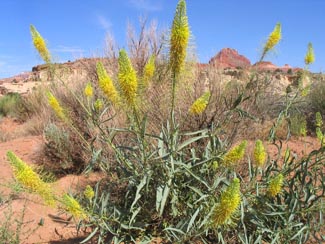Desert Princesplume

Common Name(s):
Desert Princesplume
Princes Plume
Scientific Name:
Stanleya pinnata (Pursh) Britt.
Scientific Name Synonyms:
None known
Symbol:
STPI
Description:
Life Span: Perennial
Origin: Native
Season: Cool
Growth Characteristics: A woody-based forb, with 1 to several stems that are mostly unbranched. Any branching occurs in the upper parts of the plant. Grows 1 to 3 feet tall, and flowers April to August. Reproduces from seeds.
Flowers/Inflorescence: Golden to yellow in a long stipitate raceme. Flowers have four petals, with stamens extending beyond the flower.
Fruits/Seeds: Fruit a silique (capsule), with seeds in 1 row. Occurs on an elongated pedicel.
Leaves: Alternate, simple, and light green, growing ½ to 2 inches wide and 2 to 4 inches long. Margins are sometimes deeply lobed. Basal leaves are usually absent at flowering.
Ecological Adaptions:
Occurs in the hills, plains, valleys, and desert washes. In Utah, it is most common in the dry desert grasslands. It is a reliable indicator of selenium in the soil.
Soils: Adapted to a broad range of soils, most abundant on dry soils.
Associated Species: Galleta, blue grama, rabbitbrush, and sagebrush.
Uses and Management:
Prince's plume is poisonous throughout the growing season, accumulating selenium. It is rarely consumed when other forage is available in early spring.
Pioneers and American Indians cooked and ate the stems and leaves. Uranium prospectors used is as an indicator of uranium deposits because of the relationships of selenium and uranium.

